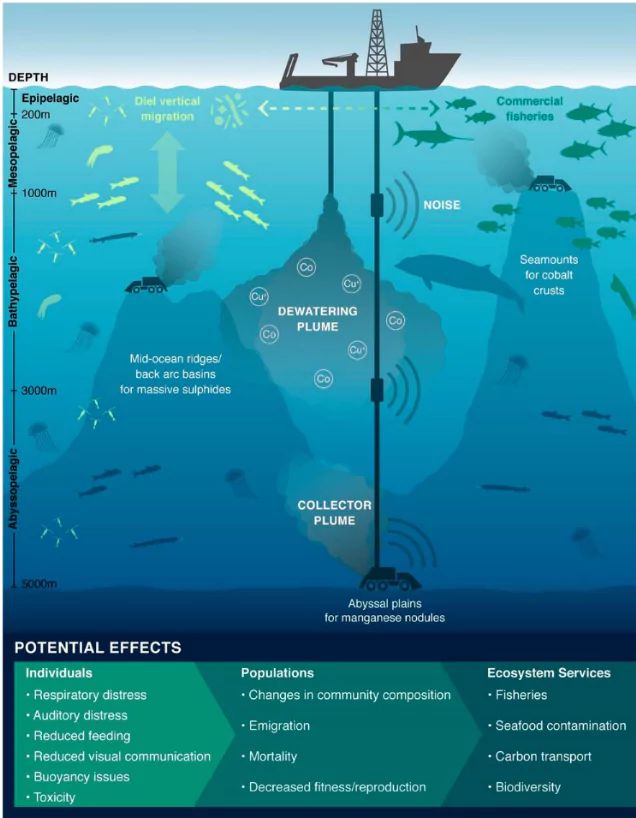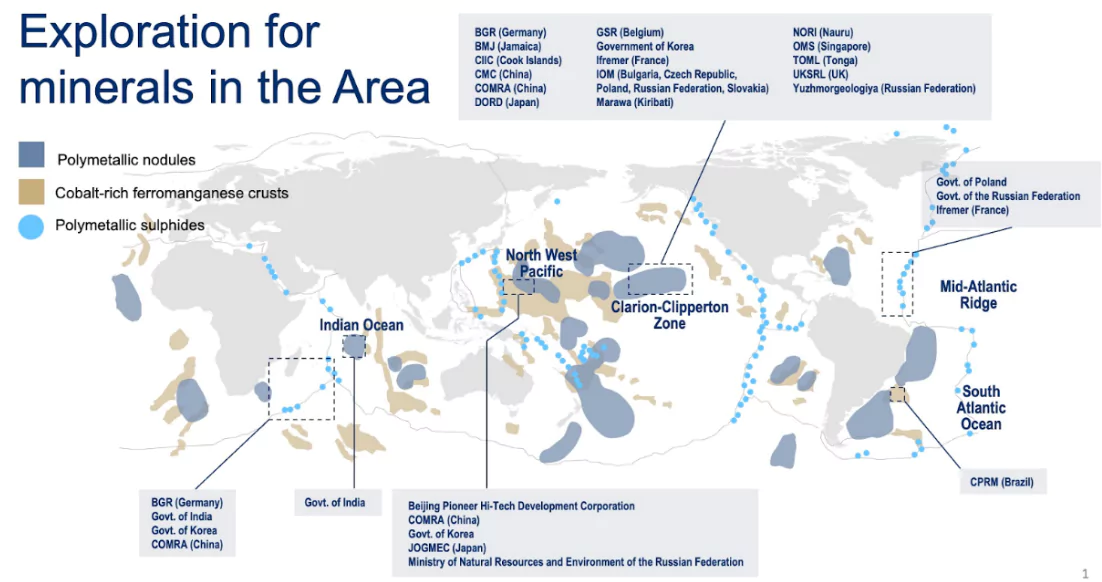A recent study titled, “Long-term impact and biological recovery in a deep-sea mining track” has highlighted the long-term impact of deep sea mining.
Key highlights About the Study
- Title: Long-term impact and biological recovery in a deep-sea mining track
 Published In: The study was published in the journal Nature.
Published In: The study was published in the journal Nature.- Conducted By: The Study was carried out by a team of scientists led by Britain’s National Oceanography Centre.
- Part of: The study forms part of the NOC-led ‘Seabed mining and resilience to experimental impact’ (SMARTEX) project, funded by the Natural Environment Research Council (NERC).
- Analysis: The study examined an 8-metre strip of the Pacific Ocean’s seafloor in the to gauge the impact of a small-scale mining experiment removing polymetallic nodules off seabed carried out in 1979.
- The site was chosen to investigate potential timescales for recovery and what traces remain 44 years after the mining machinery left.
- Findings:
- Physical Geological Changes: Mining has caused long-term changes to the sediments due to its propulsion design and has still not recovered, reducing the populations of many of the larger organisms living there.
- First Signs of Biological Recovery: Some small and mobile animal groups living on the sediment surface were showing the first signs of recolonisation and repopulation
- A type of large, amoeba-like xenophyophore, creatures commonly found everywhere in the CCZ region, had recolonised the track areas.
- Recovery of Large Animals: Large-sized animals that are fixed to the sea floor are still very rare in the tracks, showing little to no signs of recovery
- Impact of Sediment Plumes: Sediment plumes previously considered likely to have a major impact on the sea-floor community had limited long-term physical impacts and no detectable negative effects on animal numbers.
About Deep Sea Mining
- Deep sea mining is the process of extracting and excavating mineral deposits and metals from the ocean’s seabed ie. the ocean below 200m.
- Targeted Mineral Deposits:
- Polymetallic Nodules: These are rock-like formations rich in metals like manganese, nickel, copper, and cobalt, found on the abyssal plains.
- Cobalt-Rich Crusts: These are deposits of cobalt, manganese, and nickel found on the surfaces of rocks on seamounts (underwater mountains).
- Seafloor Massive Sulfides (SMS): These are deposits formed around hydrothermal vents, containing high concentrations of metals like copper, gold, silver, and zinc.
- Authority: The International Seabed Authority (ISA) regulates activities in the seabed beyond national jurisdiction and decides on the question of allowing deep-sea mining and under what conditions.
- The ISA is developing regulations to govern the transition to exploitation and is currently accepting mining permit applications from companies and countries.
- Current Status of Deep-Sea Mining: Deep-sea mining has not yet been undertaken commercially as yet but exploratory mining to test equipment has occurred at a small scale.
- Mineral Exploration: The ISA had issued 31 contracts to explore deep-sea mineral deposits forming more than 1.5 million km2 of international seabed till 2022.
 Exploration Contracts with India: India holds two exploration contracts in the Indian Ocean and applied for two more in 2024.
Exploration Contracts with India: India holds two exploration contracts in the Indian Ocean and applied for two more in 2024.
- Central Mid-Ocean Ridge: It is a triple junction area in the international water region. Here, hydrothermal sulphide deposits that contain multi-metals such as gold, platinum, and other minerals are explored.
- Central Indian Ocean: Here, poly-metallic nodules are explored.
- Potential Benefits of Deep-Sea Mining:
- Decarbonisation Efforts: Deep sea resources can help meet the critical future need for critical minerals necessary for scaling the decarbonization efforts.
- Surge in Global Demand: It is estimated to rise by as much as 400%-600% in the coming decades for some such minerals as the world increases its reliance on wind and solar power, electric vehicles, batteries and other zero-carbon technologies.
- Complement Land Based Source: The depletion of mineral resources on land and hurdles in locating viable reserves and quickly scaling up mining and processing operations will be complemented by the resources for deep sea maintaining a continuous flow in supply chain.
- Concerns Regarding Deep Sea MIning:
- Increased Pollution: Marine Species such as whales, tuna and sharks could be affected by noise, vibrations and light pollution caused by mining equipment and surface vessels, as well as potential leaks and spills of fuel and toxic products.
- Sediment Plumes: Mining of surface will stir up fine sediments on the seafloor, creating plumes of suspended particles which could smother animals, harm filter-feeding species, and block their visual communication.
- The problem will be exacerbated by mining ships discharging waste water at the surface.
- Habitat Destruction: The digging and gauging of the ocean floor by can alter or destroy deep-sea habitats which will result in species extinction many of endemic nature and the fragmentation or loss of ecosystem structure and function
- Exacerbating Climate Change: Deep-sea mining could exacerbate the process of climate change as it will disrupt the carbon sink ( absorbing and storing large amounts of carbon dioxide) properties of deep sea.
- No Governance Structure: There are concerns about the lack of effective international regulations and governance to ensure that deep-sea mining is conducted responsibly and sustainably.
- Economic and Social Risks: The deep-sea mining industry would need shoreline facilities for processing or transhipment of material requiring land acquisition and development, driving habitat loss affecting coastal communities dependent on marine resources the most.
![]() 31 Mar 2025
31 Mar 2025

 Published In: The study was published in the journal Nature.
Published In: The study was published in the journal Nature. Exploration Contracts with India: India holds two exploration contracts in the Indian Ocean and applied for two more in 2024.
Exploration Contracts with India: India holds two exploration contracts in the Indian Ocean and applied for two more in 2024.
